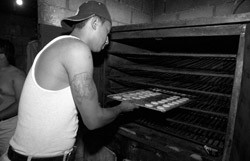
For many years, Omar was known as “The Devil.” Like many youth in his neighborhood, he was the member of a gang. More lucky than some of his childhood friends who are now dead, Omar managed to leave the gang and join a USAID-sponsored program for youth at risk.
Oscar’s story is not unusual. The challenges facing young women and men in Guatemalan society are staggering: only two out of every ten youth attend high school. Half of all Guatemalan women have a child before the age of 19. By the time they reach 30, many have given birth to seven or more children. Job training and steady jobs are hard to come by. Confronted by more obstacles than opportunities, many urban and rural youth are driven to seek identity and acceptance on the streets, where they fall victim to exploitative labor practices, drug trafficking and abuse, gang culture, and violence. It is estimated that as many as 140,000 young people in Guatemala participate in gangs or gang activity.
Two years ago, USAID launched an initiative with Guatemala’s government and private businesses to give vulnerable and at-risk youth life skills and constructive alternatives to help prevent them from accepting questionable jobs and “dirty money.” The initiative also works with former gang members to help them return to an honest and violence-free life through job training and community programs.
The program also promotes initiatives such as cultural festivals, mural painting contests, theater, and sports competitions. Since September 2004, over 1,200 at-risk and vulnerable youth have received life and work skills training and accelerated primary education, and approximately 100 youth have been employed.
Omar has now finished the fourth grade, and one day hopes to attend college. Thanks to his determination and USAID, he will undoubtedly be an example for many other former gang members. Through this USAID-led initiative, vulnerable and at-risk youth have shown they will steer away from a life of crime if provided with opportunities and training they need to become productive citizens and lead successful lives.







Comment
Make a general inquiry or suggest an improvement.